Great Pyramid of Giza › Old Kingdom of Egypt » Ancient origins
Articles and Definitions › Contents
- Great Pyramid of Giza › Antique Origins
- Old Kingdom of Egypt › Ancient History
Ancient civilizations › Historical and archaeological sites
Great Pyramid of Giza › Antique Origins
Definition and Origins
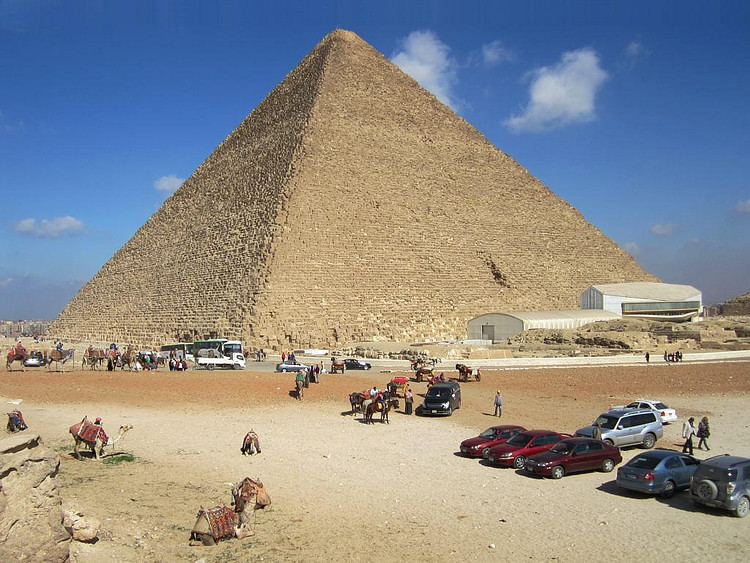
The Great Pyramid of Giza is a defining symbol of Egypt and the last of the ancient Seven Wonders of the World. It is located on the Giza plateau near the modern city of Cairo and was built over a twenty-year period during the reign of the king Khufu (2589-2566 BCE, also known as Cheops) of the 4th Dynasty. Until the Eiffel Tower was completed in Paris, France in 1889 CE, the Great Pyramid was the tallest structure made by human hands in the world; a record it held for over 3,000 years and one unlikely to be broken. Other scholars have pointed to the Lincoln Cathedral spire in England, built in 1300 CE, as the structure which finally surpassed the Great Pyramid in height but, still, the Egyptian monument held the title for an impressive span of time. The pyramid rises to a height of 479 feet (146 metres) with a base of 754 feet (230 metres) and is comprised of over two million blocks of stone. Some of these stones are of such immense size and weight (such as the granite slabs in the King's Chamber) that the logistics of raising and positioning them so precisely seems an impossibility by modern standards.
The pyramid was first excavated using modern techniques and scientific analysis in 1880 CE by Sir William Matthew Flinders Petrie (1853-1942 CE), the British archaeologist who set the standard for archaeological operations in Egypt generally and at Giza specifically. Writing on the pyramid in 1883 CE, Flinders Petrie noted:
The Great Pyramid has lent its name as a sort of by-word for paradoxes; and, as moths to a candle, so are theorisers attracted to it (1).
ALTHOUGH MANY THEORIES PERSIST AS TO THE PURPOSE OF THE PYRAMID, THE MOST WIDELY ACCEPTED UNDERSTANDING IS THAT IT WAS CONSTRUCTED AS A TOMB FOR KING KHUFU.
Although many theories persist as to the purpose of the pyramid, the most widely accepted understanding is that it was constructed as a tomb for the king. Exactly how it was built, however, still puzzles people in the modern day. The theory of ramps running around the outside of the structure to move the blocks into place has been largely discredited. So-called "fringe" or "New Age" theories abound, in an effort to explain the advanced technology required for the structure, citing extra-terrestrials and their imagined frequent visits to Egypt in antiquity. These theories continue to be advanced in spite of the increasing body of evidence substantiating that the pyramid was built by the ancient Egyptians using technological means which, most likely, were so common to them that they felt no need to record them. Still, the intricacy of the interior passages, shafts, and chambers (The King's Chamber, Queen's Chamber, and Grand Gallery) as well as the nearby Osiris Shaft, coupled with the mystery of how the pyramid was built at all and its orientation to cardinal points, encourages the persistence of these fringe theories.
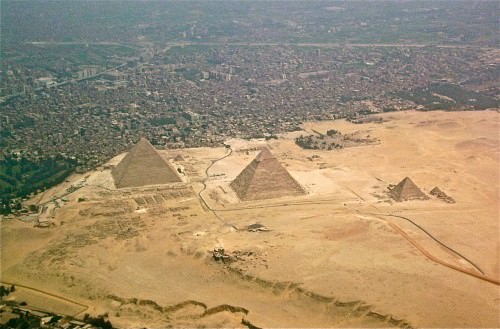
The Pyramids of Giza
PYRAMIDS & THE GIZA PLATEAU
Toward the end of the Early Dynastic Period (c. 3150-c.2613 BCE) the vizier Imhotep ((c. 2667-2600 BCE) devised a means of creating an elaborate tomb, unlike any other, for his king Djoser. Prior to Djoser's reign (c. 2670 BCE) tombs were constructed of mud fashioned into modest mounds known as mastabas. Imhotep conceived of a then-radical plan of not only building a mastaba out of stone but of stacking these structures on top of one another in steps to create an enormous, lasting, monument. His vision led to the creation of Djoser's Step Pyramid at Saqqara, still standing in the present day, the oldest pyramid in the world.
Still, the Step Pyramid was not a "true pyramid" and, in the period of the Old Kingdom (c. 2613-2181 BCE) the king Sneferu (c. 2613-2589 BCE) sought to improve on Imhotep's plans and create an even more impressive monument. His first attempt, the Collapsed Pyramid at Meidum, failed because he departed too widely from Imhotep's design. Sneferu learned from his mistake, however, and went to work on another - the Bent Pyramid - which also failed because of miscalculations in the angle from base to summit. Undeterred, Sneferu took what he learned from that experience and built the Red Pyramid, the first true pyramid constructed in Egypt.
Building a pyramid required enormous resources and the maintenance of a wide array of all kinds of skilled and unskilled workers. The kings of the 4th Dynasty - often referred to as "the pyramid builders" - were able to command these resources because of the stability of the government and the wealth they were able to acquire through trade. A strong central government, and a surplus of wealth, were both vital to any efforts at pyramid building and these resources were passed from Sneferu, upon his death, to his son Khufu.
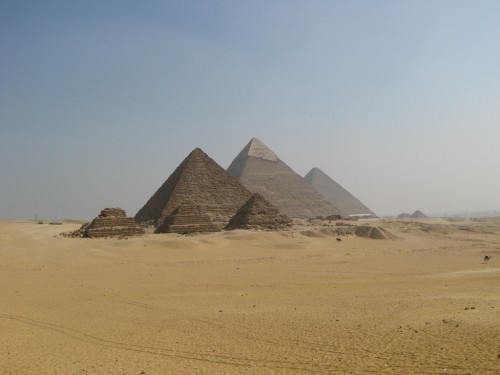
The Pyramids of Giza
Khufu seems to have set to work on building his grand tomb shortly after coming to power. The rulers of the Old Kingdom governed from the city of Memphis and the nearby necropolis of Saqqara was already dominated by Djoser's pyramid complex while other sites such as Dashur had been used by Sneferu. An older necropolis, however, was also close by and this was Giza. Khufu's mother, Hetepheres I (c. 2566 BCE), was buried there and there were no other great monuments to compete for attention close by; so Khufu chose Giza as the site for his pyramid.
CONSTRUCTION OF THE PYRAMID
The first step in constructing a pyramid, after deciding upon the best location, was organizing the crews and allocating resources and this was the job of the second-most powerful man in Egypt, the vizier. Khufu's vizier was Hemiunu, his nephew, credited with the design and building of the Great Pyramid. Hemiunu's father, Nefermaat (Khufu's brother) had been Sneferu's vizier in his pyramid-building projects and it is probable he learned a great deal about construction from these experiences.
The vizier was the final architect of any building project and had to delegate responsibility for materials, transport, labor, payments and any other aspect of the work. Written receipts, letters, diary entries, official reports to and from the palace all make clear that a great building project was accomplished at Giza under Khufu's reign but not one of these pieces of evidence suggest exactly how the pyramid was created. The technological skill evident in the creation of the Great Pyramid still mystifies scholars, and others, in the present day. Egyptologists Bob Brier and Hoyt Hobbs comment on this:
Because of their immense size, building pyramids posed special problems of both organization and engineering.Constructing the Great Pyramid of the pharaoh Khufu, for example, required that more than two million blocks weighing from two to more than sixty tons be formed into a structure covering two football fields and rising in a perfect pyramidal shape 480 feet into the sky. Its construction involved vast numbers of workers which, in turn, presented complex logistical problems concerning food, shelter, and organization. Millions of heavy stone blocks needed not only to be quarried and raised to great heights but also set together with precision in order to create the desired shape. (217)
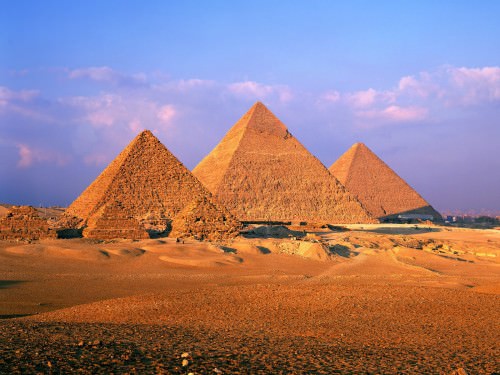
The Pyramids of Giza
It is precisely the skill and technology required to "create the desired shape" which presents the problem to anyone trying to understand how the Great Pyramid was built. Modern-day theories continue to fall back on the concept of ramps which were raised around the foundation of the pyramid and grew higher as the structure grew taller. The ramp theory, largely discredited but still repeated in one form or another, maintains that, once the foundation was firm these ramps could have easily been raised around the structure as it was built and provided the means for hauling and positioning tons of stones in precise order.Aside from the problems of a lack of wood in Egypt to make an abundance of such ramps, the angles workers would have had to move the stones up, and the impossibility of moving heavy stone bricks and granite slabs into position without a crane (which the Egyptians did not have), the most serious problem comes down to the total impracticability of the ramp theory. Brier and Hobbs explain:
The problem is one of physics. The steeper the angle of an incline, the more effort necessary to move an object up that incline. So, in order for a relatively small number of men, say ten or so, to drag a two-ton load up a ramp, its angle could not be more than about eight percent. Geometry tells us that to reach a height of 480 feet, an inclined plane rising at eight percent would have to start almost one mile from its finish. It has been calculated that building a mile-long ramp that rose as high as the Great Pyramid would require as much material as that needed for the pyramid itself - workers would have had to build the equivilent of two pyramids in the twenty-year time frame. (221)
A variation on the ramp theory was proposed by the French architect Jean-Pierre Houdin who claims ramps were used inside of the pyramid. Houdin believes that ramps may have been used externally in the initial stages of construction but, as the pyramid grew taller, work was done internally. The quarried stones were brought in through the entrance and moved up the ramps to their position. This, Houdin claims, would account for the shafts one finds inside the pyramid. This theory, however, does not account for the weight of the stones or the number of workers on the ramp required to move them up an angle inside the pyramid and into position.
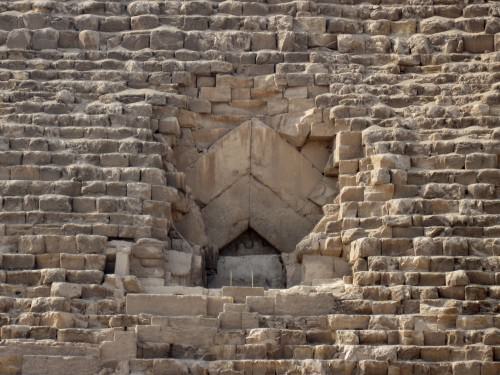
Entrance Passage, Great Pyramid of Giza
The ramp theory in either of these forms fails to explain how the pyramid was built while a much more satisfactory possibility rests right below the monument: the high water table of the Giza plateau. Engineer Robert Carson, in his work The Great Pyramid: The Inside Story, suggests that the pyramid was built using water power. Carson also suggests the use of ramps but in a much more cogent fashion: the interior ramps were supplemented by hydraulic power from below and hoists from above.Although the Egyptians had no knowledge of a crane as one would understand that mechanism the present day, they did have the shaduf, a long pole with a bucket and rope at one end and counter-weight at the other, typically used for drawing water from a well. Hydraulic power from below, coupled with hoists from above could have moved the stones throughout the interior of the pyramid and this would also account for the shafts and spaces one finds in the monument which other theories have failed to fully account for.
It is abundantly clear that the water table at Giza is still quite high in the present day and was higher in the past. Egyptologist Zahi Hawass, writing on his excavation of the Osiris Shaft near the Great Pyramid in 1999 CE, notes how "the excavation proved to be very challenging mainly due to the dangerous nature of the work caused by the high water table" (381). In the same article, Hawass notes how, in 1945 CE, guides at Giza were regularly swimming in the waters of this underground shaft and that "the rising water table in the shaft prevented scholars from studying it further" (379). Further, earlier attempts to excavate the Osiris Shaft - by Selim Hassan in the 1930's CE - and observations (though no excavation) of the shaft by Abdel Moneim Abu Bakr in the 1940's CE - also make note of this same high water table. Geological surveys have determined that the Giza plateau and surrounding region was much more fertile in the time of the Old Kingdom than it is today and that the water table would have been higher.
Considering this, Carson's theory of water power used in building the pyramid makes the most sense. Carson claims the monument "could only be constructed by means of hydraulic power; that a hydraulic transportation system was set up inside the Great Pyramid" (5). Harnessing the power of the high water table, the ancient builders could have constructed the pyramid much more reasonably than by some form of exterior ramping system.
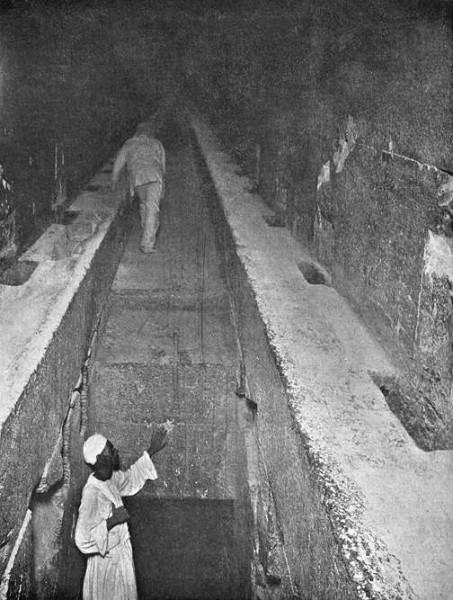
Interior Passage, Great Pyramid of Giza
Once the interior was completed, the whole of the pyramid was covered in white limestone which would have shone brilliantly and been visible from every direction for miles around the site. As impressive as the Great Pyramid is today, one must recognize that it is a monument in ruin as the limestone long ago fell away and was utilized as building material for the city of Cairo (just as the nearby city of ancient Memphis was). When it was completed, the Great Pyramid must have appeared as the most striking creation the Egyptians had ever seen. Even today, in its greatly weathered state, the Great Pyramid inspires awe.The sheer size and scope of the project is literally amazing. Historian Marc van de Mieroop writes:
The size boggles the mind: it was 146 meters high (479 feet) by 230 meters at the base (754 feet). We estimate that it contained 2,300,000 blocks of stone with an average weight of 2 and 3/4 tons some weighing up to 16 tons. Khufu ruled 23 years according to the Turin Royal Canon, which would mean that throughout his reign annually 100,000 blocks - daily about 285 blocks or one every two minutes of daylight - had to be quarried, transported, dressed, and put in place...The construction was almost faultless in design. The sides were oriented exactly toward the cardinal points and were at precise 90-degree angles. (58)
The workers who accomplished this were skilled and unskilled laborers hired by the state for the project. These workers either volunteered their efforts to pay off a debt, for community service, or were compensated for their time. Although slavery was an institution practiced in ancient Egypt, no slaves, Hebrew or otherwise, were used in creating the monument. Brier and Hobbs explain the logistics of the operation:
Were it not for the two months every year when the Nile 's water covered Egypt's farmland, idling virtually the entire workforce, none of this construction would have been possible. During such times, a pharaoh offered food for work and the promise of a favored treatment in the afterworld where he would rule just as he did in this world.For two months annually, workmen gathered by the tens of thousands from all over the country to transport the blocks a permanent crew had quarried during the rest of the year. Overseers organized the men into teams to transport the stones on sleds, devices better suited than wheeled vehicles to moving weighty objects over shifting sand. A causeway, lubricated by water, smoothed the uphill pull. No mortar was used to hold the blocks in place, only a fit so exact that these towering structures have survived for 4,000 years (17-18).

The Pyramids
The yearly inundation of the Nile River was essential for the livelihood of the Egyptians in that it deposited rich soil from the riverbed all across the farmlands of the shore; it also, however, made farming those lands an impossibility during the time of the flood. During these periods, the government provided work for the farmers through labor on their great monuments. These were the people who did the actual, physical, work in moving the stones, raising the obelisks, building the temples, creating the pyramids which continue to fascinate and inspire people in the present day. It is a disservice to their efforts and their memory, not to mention the grand culture of the Egyptians, to continue to insist that these structures were created by poorly treated slaves who were forced into their condition because of ethnicity. The biblical Book of Exodus is a cultural myth purposefully created to distinguish one group of people living in the land of Canaan from others and should not be regarded as history.
IT IS A DISSERVICE TO THEIR EFFORTS & THEIR MEMORY, NOT TO MENTION THE GRAND CULTURE OF THE EGYPTIANS, TO CONTINUE TO INSIST THAT THESE STRUCTURES WERE CREATED BY POORLY TREATED SLAVES.
THE GREAT PYRAMID AS TOMB
All of this effort went to creating a grand tomb for the king who, as mediator between the gods and the people, was thought to be deserving of the finest of tombs. Theories regarding the original purpose of the Great Pyramid range from the fanciful to the absurd and may be investigated elsewhere but the culture which produced the monument would have regarded it as a tomb, an eternal home for the king. Tombs which have been excavated throughout Egypt, from the most modest to the rich example of Tutankhamun 's - along with other physical evidence - make clear the ancient Egyptian belief in a life after death and the concern for the soul's welfare in this new world. Grave goods were always placed in the tomb of the deceased as well as, in wealthier tombs, inscriptions and paintings on the walls (known as the Pyramid Texts, in some cases). The Great Pyramid is simply the grandest form of one of these tombs.
Arguments against the Great Pyramid as a tomb cite the fact that no mummies or grave goods have ever been found inside.This argument willfully ignores the plentiful evidence of grave robbing from ancient times to the present. Egyptologists from the 19th century CE onwards have recognized that the Great Pyramid was looted in antiquity and, most likely, during the time of the New Kingdom (c. 1570-1069 BCE) when the Giza necropolis was replaced by the area now known as The Valley of the Kings near Thebes.
This is not to suggest that Giza was forgotten, there is ample evidence of New Kingdom pharaohs such as Ramesses the Great (1279-1213 BCE) taking great interest in the site. Rameses II had a small temple built at Giza in front of the Sphinx as a token of honor and it was Rameses II's fourth son, Khaemweset, who devoted himself to preserving the site. Khaemweset never ruled Egypt but was a crown prince whose efforts to restore the monuments of the past are well documented. He is, in fact, considered the world's "first Egyptologist" for his work in restoration, preservation, and recording of ancient monuments and especially for his work at Giza.
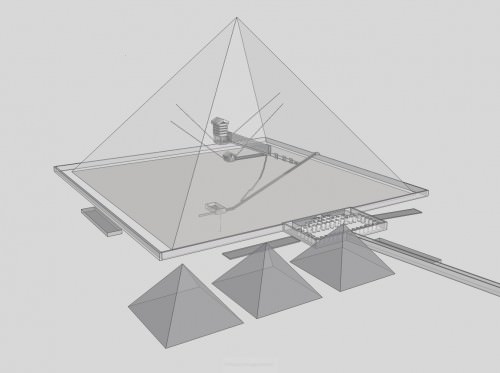
Interior Design, Great Pyramid of Giza
Further, work conducted on the Osiris Shaft - and other areas around the site - have shown activity during the 26th Dynasty of the Third Intermediate Period (c. 1069-525 BCE) and into the Late Period (c. 525-332 BCE). Giza was, therefore, an active site throughout Egypt's history but was not always given the kind of attention it received during the Old Kingdom. Herodotus, writing in the 5th century BCE, reported that the Great Pyramid had been looted and visitor's to the site in the modern day enter through the so-called Robbers Tunnel created c. 820 CE by Caliph al-Ma'mun seeking to recover whatever treasures the pyramid held inside. Tomb robbers before and after the caliph had also visited the pyramid prior to the excavations of the 19th century CE. Whatever treasures the pyramid may have held in the time of Khufu could have been removed at any time from the Old Kingdom onward.
THE GIZA PLATEAU
Following Khufu's death, his son Khafre (2558-2532 BCE) took the throne and began building his own pyramid next to his father's. The king Menkaure (2532-2503 BCE) came after Khafre and followed the same paradigm of building his eternal home at Giza. Khafre and Menkaure added their own temple complexes and monuments, such as the Great Sphinx of Giza under Khafre's reign, but these were on a smaller scale than that of Khufu's work. It is no accident or mystery as to why the Great Pyramid is the largest and the other two are progressively smaller: as the period of the Old Kingdom continued, with the government's emphasis on grand building projects, resources became more and more scarce. Menkaure's successor, Shepseskaf (2503-2498 BCE) had the resources to complete Menkaure's pyramid complex but could afford no such luxury for himself; he was buried in a modest mastaba tomb at Saqqara.
Still, Giza continued be regarded as an important site and funds were allocated as long as they were available for its upkeep.Giza was a thriving community for centuries with temples, shops, a market place, housing, and a sturdy economy. Individuals in the present day speculating on the lonely, deserted, mystical outpost of Giza ignore the evidence of what the complex would have been like for most of Egypt's long history. The present day understanding of the plateau as some isolated outpost of monuments encourages theories which do not align with how Giza actually was when those monuments were constructed.Theories suggesting mysterious tunnels beneath the plateau have been debunked - yet still persist - including speculations concerning the Osiris Shaft.
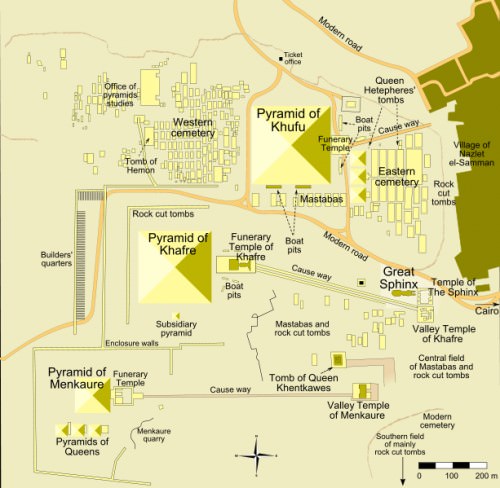
Map of the Monuments at Giza
This complex of underground chambers was most likely dug, as Hawass contends, in honor of the god Osiris and may or may not have been where the king Khufu was originally laid to rest. Herodotus mentions the Osiris Shaft (though not by that name, which was only given to it recently by Hawass) in writing of Khufu's burial chamber which was said to be surrounded by water.Excavations of the shaft and the chambers have recovered artifacts dating from the Old Kingdom through the Third Intermediate Period but no tunnels branching out beneath the plateau. Osiris, as lord of the dead, would certainly have been honored at Giza and underground chambers recognizing him as ruler in the afterlife were not uncommon throughout Egypt's history.
Although the Great Pyramid of Giza, and the other smaller pyramids, temples, monuments, and tombs there, continued to be respected throughout Egypt's history, the site fell into decline after the Roman occupation and then annexation of the country in 30 BCE. The Romans concentrated their energies on the city of Alexandria and the abundant crops the country offered, making Egypt into Rome 's "bread basket", as the phrase goes. The site was more or less neglected until Napoleon's Egyptian Campaign of 1798-1801 CE during which he brought along his team of scholars and scientists to document ancient Egyptian culture and monuments. Napoleon's work in Egypt attracted others to the country who then inspired still others to visit, make their own observations, and conduct their own excavations.
Throughout the 19th century CE, ancient Egypt became increasingly the object of interest for people around the world.Professional and amateur archaeologists descended upon the country seeking to exploit or explore the ancient culture for their own ends or in the interests of science and knowledge. The Great Pyramid was first fully excavated professionally by the British archaeologist Sir William Matthew Flinders Petrie whose work on the monument lay the foundation for any others who followed up to the present day.
Flinders Petrie was obviously interested in exploring every nuance of the Great Pyramid but not at the expense of the monument itself. His excavations were performed with great care in an effort to preserve the historical authenticity of the work he was examining. Although this may seem a common sense approach in the modern day, many European explorers before Flinders Petrie, archaeologists professional and amateur, brushed aside any concerns of preservation in pursuing their goal of unearthing ancient treasure troves and bringing antiquities back to their patrons. Flinders Petrie established the protocol regarding ancient monuments in Egypt which is still adhered to in the present day. His vision inspired those who came after him and it is largely due to his efforts that people today can still admire and appreciate the monument known as the Great Pyramid of Giza.
Old Kingdom of Egypt › Ancient History
Definition and Origins
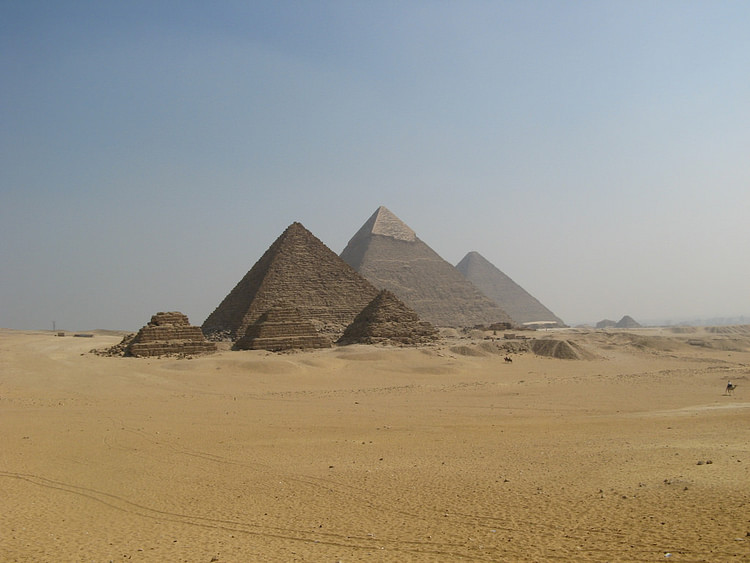
The Old Kingdom of Egypt (c. 2613-2181 BCE) is also known as the 'Age of the Pyramids ' or 'Age of the Pyramid Builders' as it includes the great 4th Dynasty when King Sneferu perfected the art of pyramid building and the pyramids of Giza were constructed under the kings Khufu, Khafre, and Menkaure. The historical records of this period, the 4th-6th Dynasties of Egypt, are scarce and historians regard the history of the era as literally 'written in stone' and largely architectural in that it is through the monuments and their inscriptions that scholars have been able to construct a history. The pyramids themselves relay scant information on their builders, but the mortuary temples built nearby and the stelae which accompanied them provide king's names and other important information. Further, inscriptions in stone found elsewhere from the time record various events and the dates on which they occurred. Finally, the tomb of the last king of the 5th Dynasty, Unas, provides the first Pyramid Texts (elaborate paintings and inscriptions inside the tomb) which shed light on the religious beliefs of the time.
The pyramids, though, are primarily what the Old Kingdom is most famous for. Historian Marc van de Mieroop writes how the Old Kingdom is "possibly unparalleled in world history for the amount of construction they undertook" (52). The pyramids at Giza, and elsewhere, during this period required unprecedented bureaucratic efficiency to organize the labor force which built the pyramids, and this bureaucracy could only have functioned under a strong central government. Van de Mieroop continues:
Most of the 20-some kings compelled thousands of laborers to quarry, transport, put in place, and decorate vast quantities of stone in order to construct royal mortuary monumnets. They diverted enormous resources from the entire country for this purpose, filling a 70-kilometer-long stretch of the desert edge along the west bank of the Nile near modern Cairo with huge monuments still awe-inspiring today despite the ravages of time (52).
The 4th Dynasty of the Old Kingdom was a time of progress and a strong centralized government which could command the kind of respect necessary for such building projects. During the 5th and 6th Dynasty, however, the priesthood began to grow in power, primarily through their hold over the very mortuary practices which gave rise to the great pyramids, empowering the local officials of the districts and the kingship suffered. The Old Kingdom began to collapse as more and more local governors assumed more power over their regions, and the central government at Memphis was increasingly seen as irrelevant.
THE 4TH DYNASTY OF THE OLD KINGDOM WAS A TIME OF PROGRESS & A STRONG CENTRALIZED GOVERNMENT WHICH COULD COMMAND THE KIND OF RESPECT NECESSARY FOR HUGE BUILDING PROJECTS.
At the end of the 6th Dynasty, there was no longer a central government of note and Egypt entered a period of social unrest and reformation known as The First Intermediate Period (2181-2040 BCE) during which Egypt was ruled regionally by local magistrates who made and enforced their own laws. The rise of these local officials and the power of the priesthood were not the only causes of the collapse of the Old Kingdom, however, in that a severe drought toward the end of the 6th Dynasty brought famine which the government could do nothing to alleviate. Scholars have also pointed to the exceptionally long reign of Pepi II of the 6th Dynasty as a contributing factor because he outlived his successors and left no heir to the throne.
Many scholars today no longer see the end of the Old Kingdom as a 'collapse' so much as a transition to the new paradigm of the First Intermediate Period, when local rulers governed their districts directly and the kind of wealth previously only available to nobility became more widespread. The long-standing designation of a political and cultural collapse at the end of the 6th Dynasty is still considered viable, however, in that the central government's loss of power and wealth led directly to the regional rule of the district nomarchs.
THE THIRD DYNASTY & THE OLD KINGDOM
The name 'Old Kingdom' was coined by archaeologists in the 19th century CE in an attempt to demarcate Egypt's long history.The Egyptians themselves did not refer to this period by that name and would have seen no difference between the period which preceded or succeeded it. Scholars traditionally included the Third Dynasty of Egypt (c. 2670-2613 BCE) in the period of the Old Kingdom because of the Pyramid of King Djoser at Saqqara, the first pyramid ever built in Egypt, seemed to link that dynasty to the building efforts of the 4th Dynasty, because the last king of the Third Dynasty was related to the first king of the 4th, and because Djoser and his successors ruled from Memphis ("the white walls") which remained the capital during the Old Kingdom. Recent scholarship, however, rejects that view as the construction of Djoser's pyramid is more in keeping with the Early Dynastic Period in Egypt (c. 3150-2613 BCE) than the Old Kingdom as are cultural practices and observances.
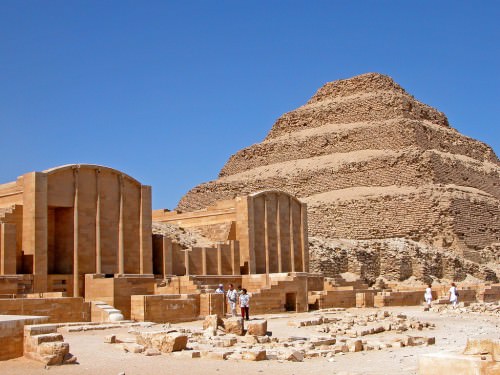
Step Pyramid Complex at Saqqara
Djoser's architect Imhotep (c. 2667-2600 BCE) revolutionized construction in Egypt by building the king's tomb at Saqqara out of stone. Prior to Imhotep's innovation, tombs and other structures were built of mud brick. The early tombs of Egypt were mud brick mastabas, but Imhotep wanted a lasting memorial to his king and so created a complex with a stone pyramid as its center and surrounding temples; thus inventing the paradigm which would be followed by every dynasty which followed to greater or lesser degrees. Further, it was during the Third Dynasty that the independent states of the country came to be known as nomes (districts) directly under the rule of a centralized government at Memphis. These developments in architecture, politics, and also in religious practices - all a departure from the past - made it clear to Egyptologists that the Third Dynasty was the beginning of a new period in Egypt's history and should be included in the Old Kingdom rather than the Early Dynastic Period.
Today, however, scholars see the Third Dynasty as a transitional phase more closely linked to the earlier period than the latter.Even though Djoser's pyramid of stone was a wholly new creation it still utilized Early Dynastic Period techniques. The pyramid at Saqqara is actually a stack of mastabas rather than a true pyramid and, regarding the political reforms and creation of nomes, the central government of the Third Dynasty did not have the reach nor command the resources of the 4th Dynasty.For these reasons and others, the Old Kingdom is now thought to begin with the 4th Dynasty of Egypt, although, it should be noted, this claim is not at all universally accepted among scholars.
THE FIRST TRUE PYRAMID
The last king of the Third Dynasty, Huni (c. 2630-2613 BCE), was long thought to have initiated the massive building projects of the Old Kingdom in constructing the pyramid at Meidum, but credit for the Meidum pyramid goes to the first king of the 4th Dynasty, Sneferu (c. 2613-2589 BCE) who may have been Huni's son by one of his minor queens. Egyptologist Barbara Watterson writes, "Sneferu initiated the golden age of the Old Kingdom, his most notable achievements being the two pyramids built for him at Dahshur" (50-51). Sneferu began his work with the pyramid at Meidum now referred to as the "collapsed pyramid" or, locally, as the "false pyramid" because of its shape: it resembles a tower more than a pyramid and its outer casing rests around it in a gigantic heap of gravel.
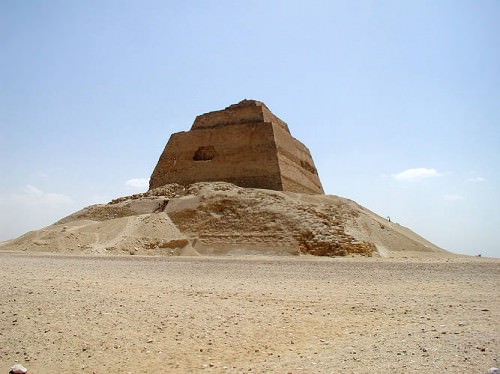
Meidum Pyramid
The pyramid of Meidum is the first true pyramid constructed in Egypt but did not last. This is because modifications were made to Imhotep's original pyramid design which resulted in the outer casing resting on a sand foundation rather than rock, causing it to collapse. Scholars are divided on whether the collapse occurred during construction or over a longer period of time.Egyptologist Miroslav Verner cites the work of the archaeologist Borchardt in claiming that the pyramid was built in stages, which increasingly had the outer foundation resting on sand while the inner foundation was securely built on rock. When the workers reached the third stage of the building process, the outer casing, the structure lacked cohesion because it had no firm footing "with the result that during the final phase of construction a massive slippage buried the workers under the rubble" (162). Other scholars, however, disagree and claim that the outer casing lasted into the New Kingdom of Egypt (1570-1069 BCE). Still others, like historian Marc van de Mieroop, claim that it is impossible to tell when the outer casing collapsed.
Unfinished temples and other structures have been found at Meidum which suggest that the pyramid complex was never finished and so argue for an early collapse of the pyramid, most likely while it was still under construction. Sneferu learned from his mistake, however, and moved on to his next two pyramids at Dahshur.
KING SNEFERU & HIS PYRAMIDS
Sneferu's pyramids at Dahshur are known as the Bent Pyramid and the Red Pyramid (or North Pyramid). The Bent Pyramid is so called because it rises at a 55-dgree angle and then shifts to 43 degrees of smaller stones giving it the appearance of bending in toward the top. The workers had completed the foundation and the sides before realizing that a 55-degree angle was too steep and modified their plan to finish the project as best they could. Sneferu seems to have understood the problem and moved on to build his third pyramid.
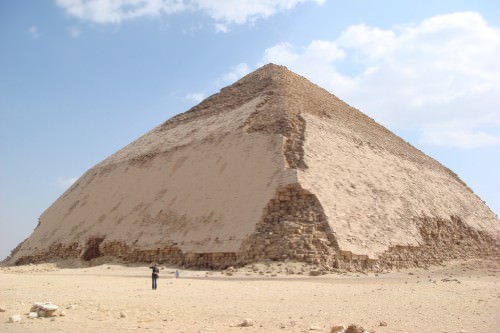
Bent Pyramid
According to inscriptions on the Palermo Stone, Sneferu was a much-admired king, who commanded great respect from his people. Barbara Watterson, commenting on the Palermo Stone inscriptions, writes:
He led military expeditions to Sinai to protect Egypt's interests in the turquoise mines, and to northern Nubia and Libya, bringing back from Nubia 7,000 prisoners and 200,000 head of cattle and, from Libya, 11,000 prisoners and 13,100 head of cattle. The prisoners were probably used to augment the work-force in quarries. In succeeding generations, Sneferu acquired the reputation of being beneficent and liberal and, according to a story recounted in the Westcar Papyrus, capable of the common touch in addressing one of his subjects as 'my brother.' (51)
Sneferu seems to have been a very accessible ruler who was undeterred by failure or disappointment. When the Bent Pyramid did not meet his expectations he simply started on a third attempt. The Red Pyramid (so called because of the use of reddish limestone in construction) was built on a solid base for greater stability, rising at a 43-degree angle. 344 feet (105 meters) high, the Red Pyramid was the first successful true pyramid built in Egypt. Originally it was encased in white limestone, as the other later pyramids were also, which fell away over the centuries and were harvested by locals for other building projects.
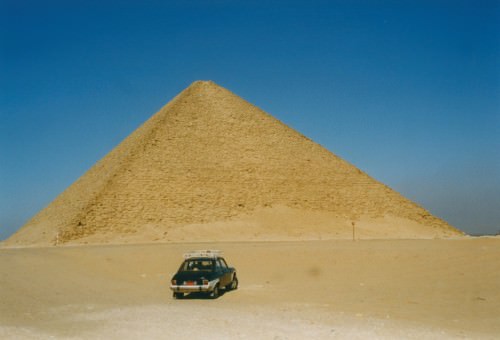
Red Pyramid
King Sneferu, through his military expeditions and judicious use of resources, established a powerful central government at Memphis which produced the kind of stability necessary for his vast building projects. Following the example of Djoser's complex at Saqqara, Sneferu had mortuary temples and other buildings constructed around his pyramids with priests taking care of the day-to-day operations once the Red Pyramid was finally completed. All of this argues for a stable society under his reign which he left to his son, Khufu, when he died.
KHUFU & THE GREAT PYRAMID
Khufu (2589-2566 BCE) was known as Cheops by the ancient Greek writers and is best known for his Great Pyramid at Giza.The Greeks depicted him as a tyrant in their writings who oppressed the people and forced them to work for him against their will. This impression may have been made by the stories which make up the document known as the Westcar Papyrus, a collection of four stories written about the kings of the 4th Dynasty and discovered (or obtained from an antiquities dealer) in c.1824 CE by Henry Westcar. The papyrus features four stories told by sons of Khufu and includes one where King Khufu calls a magician to court who claims to be able to reattach a severed head to a body, and some scholars have interpreted his actions in asking for a demonstration as cruel or thoughtless. According to Barbara Watterson, "the Westcar Papyrus portrays him as careless with life" and other inscriptions show him as "oppressive and autocratic" (51). In the story of the magician and the severed head, however, Khufu seems mostly skeptical of the seer's abilities, and the other stories, though related by Khufu's sons or successors, have to do with other kings. The Westcar Papyrus gives no indication that Khufu was a tyrant or oppressive in any way.
Most likely, the ancient Greeks who wrote of "Cheops" as a tyrant took their lead from Herodotus, who writes that Khufu brought to Egypt "every kind of evil" for his own glory, forcing "a hundred thousand men at a time, for three months continually" to work on his pyramid (II.124). Further, Herodotus claims, Khufu was so in need of money that he sent his daughter to work in the brothels of Memphis and demand a high price for her services (II. 124). His claims have been discredited through Egyptian texts, which praise Khufu's reign, and physical evidence, which suggests the workers on the Great Pyramid were well cared for and performed their duties as part of a community service, as paid laborers, or during the time the Nile's flood made farming impossible. Scholars Bob Brier and Hoyt Hobbs note:
Were it not for the two months every year when the Nile's water covered Egypt's farmland, idling virtually the entire workforce, none of this construction would have been possible. During such times, a pharaoh offered food for work and the promise of a favored treatment in the afterworld where he would rule just as he did in this world.For two months annually, workmen gathered by the tens of thousands from all over the country to transport the blocks a permanent crew had quarried during the rest of the year. Overseers organized the men into teams to transport the stones on sleds, devices better suited than wheeled vehicles to moving weighty objects over shifting sand. A causeway, lubricated by water, smoothed the uphill pull. No mortar was used to hold the blocks in place, only a fit so exact that these towering structures have survived for 4,000 years - the only Wonders of the Ancient World still standing today. (17-18)

The Pyramids of Giza
The Great Pyramid, actually, is the only one of the structures at Giza which was considered one of the ancient Seven Wonders of the World and with good reason: until the Eifel Tower was completed in 1889 CE, the Great Pyramid was the tallest structure on earth built by human hands. Historian Marc van de Mieroop writes:
The size boggles the mind: it was 146 meters high (479 feet) by 230 meters at the base (754 feet). We estimate that it contained 2,300,000 blocks of stone with an average weight of 2 and 3/4 tons some weighing up to 16 tons. Khufu ruled 23 years according to the Turin Royal Canon, which would mean that throughout his reign annually 100,000 blocks - daily about 285 blocks or one every two minutes of daylight - had to be quarried, transported, dressed, and put in place...The construction was almost faultless in design. The sides were oriented exactly toward the cardinal points and were at precise 90-degree angles. (58)
However Herodotus and the later Greeks viewed Khufu, his people admired him. During his reign, Egypt grew even more wealthy through his military campaigns against Nubia and Libya and his very prosperous trade agreements with cities such as Byblos. He also devoted resources to improving the lives of his subjects through agricultural innovations. Miroslav Verner writes, "during his reign the earliest known dam in the world was built in Wadi Gerawi, in the mountains west of modern Helwan" (155). This dam aided the farmers and others in the community by improving the water supply.
Although Memphis remained the capital of Egypt during Khufu's reign, he most likely lived in a palace at Giza to oversee the work on the Great Pyramid himself. In order to maintain maximum efficiency in government and waste as little time as possible, he gave the greatest amount of power to his most trusted family members, who must have been pleased with the arrangement as there is no record of internal strife during his rule.
KHAFRE, THE SPHINX, & MENKAURE
After Khufu's death, he was succeeded by a family member outside the legitimate line named Djedefre (2566-2558 BCE).Verner notes that early Egyptologists considered the destruction of this king's pyramid complex in Abu Rawash to be evidence of internal family strife but, actually, the "intensive devastation began in Roman times, when the monument degenerated into a stone quarry" and the Romans used the stone for other building projects (156). Djedefre was certainly Khufu's son, but it seems he was not his chosen successor. Theories regarding family conspiracies against him, however, appear unfounded.
The most important aspect of Djedefre's reign, however, is not his pyramid or the claim that he built the Sphinx but his association of the position of king with the cult of the sun god Ra. He was the first king of Egypt to apply the title "Son of Ra" to himself marking the kingship as subordinate to the sun god. In the Second Dynasty, king Raneb had linked his name to the gods and so established the king as the gods' representative on earth, the living embodiment of the gods. After Djedefre's reform, the king would still be seen as a divine representative but now in a more subordinate position as a child of god.
Djedefre is considered by some scholars (such as Dobrev in 2004 CE) the creator of the Great Sphinx of Giza while others attribute this monument to his brother, and successor, Khafre (2558-2532 BCE). The Sphinx is the largest monolithic statue in the world depicting a reclining lion's body with the head and face of a king. Traditionally this king's face is accepted as Khafre, but Dobrev and others claim it may actually be Khufu's. It seems likely that it was created by Khafre since it is perfectly in line with his pyramid complex and the Sphinx's face seems to resemble Khafre's more than Khufu's. Brier and Hobbs write:
Khafre's pyramid rises even higher than its famous neighbor, although it actually stood ten feet shorter when it was new. Its gleaming casing of white limestone, transported by boats from quarries across the Nile, still covers the top, laid over interior limestone blocks which were cut from the surrounding Giza site. Probably in the course of freeing these interior blocks, quarrymen struck a seam of harder rock they avoided, leaving a small hill. Khafre had this outcrop carved in the shape of a recumbent lion bearing his own face - the famous Sphinx. (16)
A pirâmide de Khafre é a segunda maior em Gizé e seu complexo quase tão grandioso quanto o de seu pai. Pouco se sabe sobre seu reinado, mas os gregos (que o chamavam de Quéfren) o viam como o pai: como um tirano que oprimia seu povo no interesse de construir seu grande monumento funerário. Textos egípcios indicam que ele seguiu as políticas e o modelo de governo de seu pai ao colocar o poder nas mãos de seus familiares mais próximos e manter um rígido controle sobre as políticas e leis. Khafre se associou ao deus Horus(como os reis anteriores haviam feito), e a Esfinge era considerada uma imagem do rei como o deus Harmakhet ("Hórus no Horizonte"). Ao contrário dos reis do início do período dinástico, no entanto, Khafre - e aqueles que vieram depois dele - referiu-se a si mesmo como um "Filho de Horus", associado ao deus, mas não ao próprio deus vivo. O poder de interpretar a vontade dos deuses, embora ainda dentro da esfera de influência do rei, crescia cada vez mais na proveniência dos sacerdotes que serviam a esses deuses.
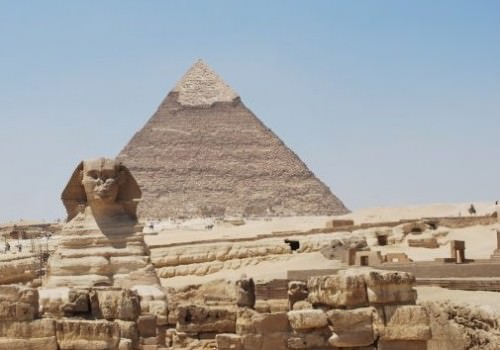
Sphinx and Khephren Pyramid
Após a morte de Khafre, a sucessão foi novamente interrompida brevemente quando Baka, filho de Djedefre, assumiu o trono. Ele nem sequer reinou um ano, no entanto, antes de Menkaure (2532-2503 aC), filho de Khafre, se tornar rei. Menkaure (conhecido como Mykerinos pelos gregos) é visto favoravelmente por ambos os gregos e os textos egípcios. Como seu pai e seu avô antes dele, Menkaure começou a construir seu complexo de pirâmides e templos em Gizé. Embora hoje o planalto de Gizé seja um antigo local varrido por areia nos arredores do Cairo, na época de Menkaure era uma cidade dos mortos habitada pelos vivos que cuidavam dela. Casas de padres, templos, casas de operários, lojas, fábricas, cervejarias e todos os aspectos de uma pequena cidade estavam presentes em Gizé.
Contrary to the popular belief that the pyramids of Giza were built by slave labor (specifically Hebrew slave labor), they were actually constructed by Egyptians, many of whom were highly skilled workers who were paid for their time. The pyramids are thought to represent the primordial mound, the ben-ben, which first rose from the waters of chaos at the beginning of creation. Although slave laborers from Nubia, Libya, even Canaan and Syria, were most likely used in the quarries cutting rock or in the gold mines, they would not have been entrusted to create the king's eternal home in the image of the first earth to rise from the waters. No slave quarters have been discovered at Giza and no Egyptian records relate any event such as that set down in the biblical Book of Exodus. Workmen's quarters, supervisor's houses, overseer's homes have all been found and make clear that the work done at the Giza plateau in the Old Kingdom was performed by Egyptians working for compensation.
Menkaure's pyramid and complex is smaller than the other two and this signifies an important development in the history of the Old Kingdom and one of the reasons why it would collapse. The resources necessary for the building of the Great Pyramid were no longer available in Menkaure's time but he still drew on what he could to create an eternal home on par with his father's and grand-father's. Menkaure's son and chosen successor, Khuenre, died while the pyramid was being built, which upset the dynastic succession, and Menkaure himself died before the pyramid complex was completed. Although he reigned for some thirty years, he was not able to complete what his predecessors had done, and to many scholars (Verner and Watterson among them) this signifies the dwindling resources at his command. His successor, Shepseskaf (2503-2498 BCE), completed Menkaure's complex at Giza but was himself buried in a fairly modest mastaba at Saqqara.
The kings, as previously noted, were diverting enormous resources to their mortuary monuments and complexes, but these temples and shrines were increasingly no longer under the king's control but that of the priests who administered them. After Shepseskaf's brief reign the 4th Dynasty came to an end and the 5th began with much less promise than when Sneferu had succeeded Huni.
THE 5TH & 6TH DYNASTIES & COLLAPSE
It was Sneferu who had first associated his dynasty with the solar cult of the god Ra, but it was Djedefre who reduced the status of the king from a living god to the son of that god. The priests grew in power at the expense of the throne but, still, the king was the representative of the gods on earth and commanded respect and power. Exactly how much respect and power was waning, however.
The 5th Dynasty is known as the dynasty of the Sun Kings because the names of so many have the god Ra's name in them (usually given as Re). The first three of these kings (Userkaf, Sahure, and Kakai) would later be honored as divinely appointed in the story The Birth of the Kings from the Westcar Papyrus. The dynasty begins with the king Userkaf (2498-2491 BCE), but a woman named Khenkaues, most probably a daughter of Menkaure, features largely in the inscriptions of the time as "Mother of Two Kings of Upper and Lower Egypt" though it is unknown who those kings were. Her tomb is the fourth pyramid at Giza, and she was obviously a very important figure, but little is known of her.
Userkaf is best known for the construction of the Temple of the Sun at Abusir. This building marks an important departure from the role of the king at the beginning of the 4th Dynasty and the beginning of the end of Giza as the necropolis of the kings. The sun god Ra was now worshiped directly by the people through the offices of the priesthood and the king's role as direct representative of the god was diminished. Barbara Watterson comments on this:
In the Fourth Dynasty one of the components of the royal titulary, the nsw-bit (King of Upper and Lower Egypt) name was occasionally written inside a cartouche, thereby signifying that the king ruled over everything that the sun's disc, or Ra, encircled. The use of the cartouche became normal in the Fifth Dynasty, when kings adopted the title "Son of Ra". In previous dynasties, kings were deemed to be the earthly manifestation of the god Horus; but, in adding the new title to the royal titulary, they reduced their status from god to son of god. The king's divine authority was further eroded in the Fifth Dynasty when temples were erected at pyramid sites not, as before, for the worship of the king, but for the celebration of the cult of Ra. (52)
Userkaf was succeeded by his son Sahure (2490-2477 BCE) who built his mortuary complex at Abusir near the Temple of the Sun. Sahure was an efficient ruler, who organized the first Egyptian expedition to the Land of Punte negociou importantes acordos comerciais com outras nações. Punt estava entre suas maiores conquistas, no entanto, uma vez que se tornaria uma importante fonte de muitos dos recursos mais valorizados do Egito e, com o tempo, considerado como uma terra mítica dos deuses. Sahure construiu seu próprio Templo para o Sol em Abusir e foi o primeiro a fazer uso das colunas palmiformes na arquitetura que se tornaria padrão para colunas em todo o Egito a partir de então (as colunas conhecidas cujos topos têm a forma de folhas de palmeira). As expedições militares de Sahure e o uso prudente de recursos enriqueceram o país, como evidenciado pelo elaborado trabalho feito em seu complexo mortuário e inscrições encontradas.
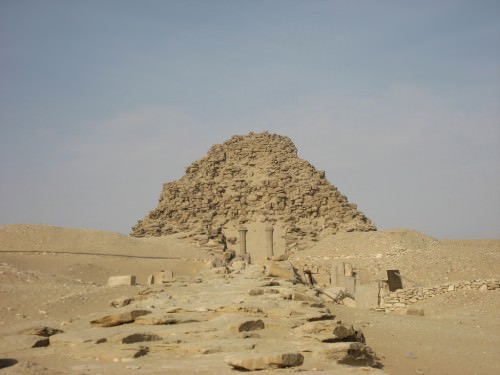
Pirâmide de Sahure
Ele foi sucedido por seu filho Neferirkare Kakai (2477-2467 aC). Inscrições indicam que ele era um bom rei e muito respeitado, mas pouco se sabe de seu reinado, exceto que o sacerdócio cresceu ainda mais poderosamente durante seu governo. Seu filho, Neferefre (2460-2458 AC), o sucedeu, mas morreu pouco tempo em seu reinado, provavelmente por volta dos 20 anos. O rei Shepsekare o sucedeu, mas nada se sabe sobre seu reinado. Ele é sucedido por Nyussere Ini (2445-2422 aC), durante cujo reinado os sacerdotes de Ra ganharam ainda mais poder. A burocracia dos templos e dos complexos funerários também aumentou, o que aumentou as pressões sobre o tesouro real que pagava pela manutenção e manutenção do templo. O rei Menkauhor Kaiu (2422-2414 AEC) o sucedeu, mas muito pouco se sabe sobre seu reinado, exceto que ele foi o último rei a construir um templo para o sol.Ele foi sucedido por Djedkare Isesi (2414-2375 aC).
As origens de Djedkare Isesi são desconhecidas. Ele não é considerado o filho de Menkauhor Kaiu, mas poderia ter sido relacionado. Seu reinado é marcado pela extensa reforma da burocracia e do sacerdócio em um esforço para manter uma economia estável. Djedkare Isesi rejeitou a prática tradicional de construir um templo para o deus sol e reduziu o número de sacerdotes necessários para a manutenção dos complexos mortuários. Ele também organizou a segunda expedição a Punt, que enriqueceu o Egito e fortaleceu ainda mais os laços com Punt.
É possível que a saída de Djedkare Isesi do culto do deus sol tenha a ver com o desenvolvimento do culto a Osíris e sua ênfase na vida eterna através da associação com o deus que havia morrido e retornado à vida. Embora o culto de Osíris não se tornasse popular até o período do Império do Meio do Egito(2040-1782 aC), as evidências sugerem fortemente que essa antiga divindade agrícola já estava associada à morte e ressurreição durante o Antigo Império. O fato de o Djedkare Isesi ter sido venerado por seu próprio culto durante séculos após sua morte apoiaria essa afirmação. O culto de Osíris se tornou mais difundido e muito mais popular do que o culto de Rá e Djedkare Isesi, como um dos primeiros adeptos reais do culto, teria recebido grande respeito dos membros posteriores.
O aspecto mais significativo do reinado de Djedkare Isesi, no entanto, foi a descentralização do governo em Memphis, que colocou maior poder nas mãos das autoridades locais. Isso foi feito para diminuir os custos da burocracia maciça que havia crescido durante a quinta e a quinta dinastias. Embora a ideia pudesse ter feito sentido, essencialmente deu mais poder às regiões onde os padres locais já eram influentes o suficiente para ordenar os administradores governamentais e assim fizeram os esforços anteriores do rei em reduzir o poder do padre quase irrelevantes.
Djedkare Isesi foi sucedido por seu filho Unas (2375-2345 aC), sobre cujo reinado pouco é conhecido. Unas foi o primeiro rei do Egito a ter o interior de seu túmulo pintado e marcado com inscrições que passaram a ser conhecidas como os Textos das Pirâmides. Essas inscrições mostram o rei em comunhão com Rá e Osíris, o que dá mais apoio à alegação de que Djedkare Isesi foi influenciado pelo culto de Osíris ao reformar o sacerdócio de Rá, em que o rei que o sucedeu (Unas) colocou os dois deuses em igualdade pé em seu túmulo.
O 6º DECLÍNIO & COLAPSO DA DINASTIA
Quando a 6ª Dinastia começou, o papel do rei já estava grandemente diminuído. Durante o reinado do primeiro rei, Teti (2345-2333 aC), autoridades locais e administradores estavam construindo túmulos mais elaborados que a nobreza. De acordo com o historiador Manetho, do século III aC, Teti foi assassinado por seus guarda-costas, um crime que teria sido impensável anteriormente. Ele foi sucedido por Userkare (2333-2332 aC), que pode ter estado por trás da conspiração para assassinar o rei. Seu reinado foi curto, e ele foi sucedido por Meryre Pepi I (2332-2283 aC) sob cujo reinado os nomarcas(administradores locais dos nomes) ficaram mais poderosos. Essa tendência continuou com o reinado de Merenre Nemtyensaf I (2283-2278 aC) e com o de Neferkare Pepi II (2278-2184 aC), que subiu ao trono ainda criança e morreu como um homem idoso, marcando um incrível reinado de perto de cem anos.
No longo reinado de Pepi II, o Velho Reino entrou em colapso. O crescente poder dos nomarcas provinciais junto com o sacerdócio erodiu a autoridade do governo central e do rei. Barbara Watterson escreve:
Perto do final da Sexta Dinastia, o poder real declinou rapidamente, devido em grande parte à cobrança insustentável sobre o tesouro real de manter os monumentos funerários de reis anteriores e de fazer presentes a nobres de equipamentos funerários e dotações de oferendas. O oferecimento de sacerdotes mortuários que serviam a um número crescente de tumbas transferia a riqueza do rei para o sacerdócio. Ao mesmo tempo, o poder dos governadores provinciais gew até que eles se tornaram barões de seus próprios feudos. (52)
Pepi II foi seguido por Merenre Nemtyemsaf II (c. 2184 AC) com um reinado muito curto, e a dinastia terminou com Netjerkare (também conhecido como Neitiqerty Siptah, 2184-2181 AC) que é identificado por alguns estudiosos e egiptólogos (como Percy). E. Newberry e Toby Wilkinson) como a rainha Nitocris do relato de Heródoto ( Histórias, Livro II.100) de uma rainha egípcia que vinga o assassinato de seu irmão por afogar seus assassinos em um banquete. Newberry oferece evidências especialmente convincentes de que o relato de Heródoto, considerado por muitos como um mito, é acurado, embora não haja registro egípcio de tal evento.
Pepi II had outlived any successors to the throne and, in his later years, appears to have been a fairly ineffective king. When a drought brought famine to the land, there was no longer any meaningful central government to respond to it. The Old Kingdom ended with the 6th Dynasty as no strong ruler came to the throne to lead the people. Local officials took care of their own communities and had no resources, nor felt the responsibility, to help the rest of the country. As the 6th Dynasty passed away, Egypt slowly tumbled into the era now classified by scholars as the First Intermediate Period.
LICENSE:
Article based on information obtained from these sources:with permission from the Website Ancient History Encyclopedia
Content is available under License Creative Commons: Attribution-NonCommercial-ShareAlike 3.0 Unported. CC-BY-NC-SA License